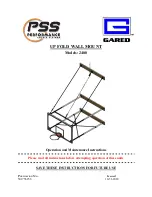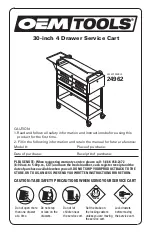
6
Knowhow is the difference
General safety
•
Never make any alterations in the product’s construction.
•
Do not use damaged or altered equipment.
•
Inspect the general condition of the dolly before each use.
•
Check for breaks, cracks or bent parts, loose or missing parts, and any other condition that could affect
the proper and safe function of the product.
•
Before use, check the dolly thoroughly. If the dolly does not appear to be working correctly, follow the
instructions in the section: Periodic maintenance and inspection.
•
The wheel dolly is a tool designed only to mount and dismount wheels on a vehicle that is already been
lifted and supported by a trestle and must not be used as an independent tool for lifting vehicles.
•
Do not lift the horizontal or vertical arm, as these are only designed to support the wheel.
•
Use the unit on a horizontal, even and solid surface in a well-lit area.
•
The wheel/load should be lifted vertically, as the load might otherwise slide out at the bottom and away
from the unit. This can cause the wheel dolly
to “shoot out” toward the user.
•
Do not use the unit to lift more than 1600 kg.
Failure to observe the max. lifting capacity could cause serious injury or damage to property.
•
Lowering a load of over 1600 kg onto the unit could result in significant damage to the wheel dolly. This
could happen, for instance, if you lower the vehicle before the user has lowered and removed the wheel
dolly after use with the vehicle.
•
Users and others must keep a safe distance of at least 0.5 m from the load.
•
The unit must not be used if it is leaking oil or if the unit is functioning in a way that is different from the
description in the operating instruction. If this is the case, stop using the dolly immediately and contact
an authorised service technician for inspection and, if needed, repair of the unit so that it may be used
safely again.
•
Make sure that warning and information signs on the product are legible and intact at all times.
•
Never perform service on the dolly while it is carrying a load.
Further updated safety information is available at www.compac.dk
under “Service”.
Failure to observe the following will result in serious bodily
injury or death, as well as damage to property.
DANGER



































